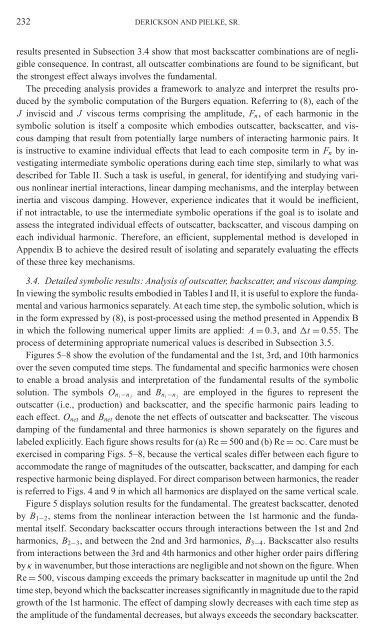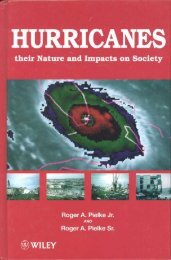A Preliminary Study of the Burgers Equation with Symbolic ...
A Preliminary Study of the Burgers Equation with Symbolic ...
A Preliminary Study of the Burgers Equation with Symbolic ...
Create successful ePaper yourself
Turn your PDF publications into a flip-book with our unique Google optimized e-Paper software.
232 DERICKSON AND PIELKE, SR.<br />
results presented in Subsection 3.4 show that most backscatter combinations are <strong>of</strong> negligible<br />
consequence. In contrast, all outscatter combinations are found to be significant, but<br />
<strong>the</strong> strongest effect always involves <strong>the</strong> fundamental.<br />
The preceding analysis provides a framework to analyze and interpret <strong>the</strong> results produced<br />
by <strong>the</strong> symbolic computation <strong>of</strong> <strong>the</strong> <strong>Burgers</strong> equation. Referring to (8), each <strong>of</strong> <strong>the</strong><br />
J inviscid and J viscous terms comprising <strong>the</strong> amplitude, Fn, <strong>of</strong> each harmonic in <strong>the</strong><br />
symbolic solution is itself a composite which embodies outscatter, backscatter, and viscous<br />
damping that result from potentially large numbers <strong>of</strong> interacting harmonic pairs. It<br />
is instructive to examine individual effects that lead to each composite term in Fn by investigating<br />
intermediate symbolic operations during each time step, similarly to what was<br />
described for Table II. Such a task is useful, in general, for identifying and studying various<br />
nonlinear inertial interactions, linear damping mechanisms, and <strong>the</strong> interplay between<br />
inertia and viscous damping. However, experience indicates that it would be inefficient,<br />
if not intractable, to use <strong>the</strong> intermediate symbolic operations if <strong>the</strong> goal is to isolate and<br />
assess <strong>the</strong> integrated individual effects <strong>of</strong> outscatter, backscatter, and viscous damping on<br />
each individual harmonic. Therefore, an efficient, supplemental method is developed in<br />
Appendix B to achieve <strong>the</strong> desired result <strong>of</strong> isolating and separately evaluating <strong>the</strong> effects<br />
<strong>of</strong> <strong>the</strong>se three key mechanisms.<br />
3.4. Detailed symbolic results: Analysis <strong>of</strong> outscatter, backscatter, and viscous damping.<br />
In viewing <strong>the</strong> symbolic results embodied in Tables I and II, it is useful to explore <strong>the</strong> fundamental<br />
and various harmonics separately. At each time step, <strong>the</strong> symbolic solution, which is<br />
in <strong>the</strong> form expressed by (8), is post-processed using <strong>the</strong> method presented in Appendix B<br />
in which <strong>the</strong> following numerical upper limits are applied: A = 0.3, and t = 0.55. The<br />
process <strong>of</strong> determining appropriate numerical values is described in Subsection 3.5.<br />
Figures 5–8 show <strong>the</strong> evolution <strong>of</strong> <strong>the</strong> fundamental and <strong>the</strong> 1st, 3rd, and 10th harmonics<br />
over <strong>the</strong> seven computed time steps. The fundamental and specific harmonics were chosen<br />
to enable a broad analysis and interpretation <strong>of</strong> <strong>the</strong> fundamental results <strong>of</strong> <strong>the</strong> symbolic<br />
solution. The symbols Oni −n j and Bni −n are employed in <strong>the</strong> figures to represent <strong>the</strong><br />
j<br />
outscatter (i.e., production) and backscatter, and <strong>the</strong> specific harmonic pairs leading to<br />
each effect. Onet and Bnet denote <strong>the</strong> net effects <strong>of</strong> outscatter and backscatter. The viscous<br />
damping <strong>of</strong> <strong>the</strong> fundamental and three harmonics is shown separately on <strong>the</strong> figures and<br />
labeled explicitly. Each figure shows results for (a) Re = 500 and (b) Re =∞. Care must be<br />
exercised in comparing Figs. 5–8, because <strong>the</strong> vertical scales differ between each figure to<br />
accommodate <strong>the</strong> range <strong>of</strong> magnitudes <strong>of</strong> <strong>the</strong> outscatter, backscatter, and damping for each<br />
respective harmonic being displayed. For direct comparison between harmonics, <strong>the</strong> reader<br />
is referred to Figs. 4 and 9 in which all harmonics are displayed on <strong>the</strong> same vertical scale.<br />
Figure 5 displays solution results for <strong>the</strong> fundamental. The greatest backscatter, denoted<br />
by B1−2, stems from <strong>the</strong> nonlinear interaction between <strong>the</strong> 1st harmonic and <strong>the</strong> fundamental<br />
itself. Secondary backscatter occurs through interactions between <strong>the</strong> 1st and 2nd<br />
harmonics, B2−3, and between <strong>the</strong> 2nd and 3rd harmonics, B3−4. Backscatter also results<br />
from interactions between <strong>the</strong> 3rd and 4th harmonics and o<strong>the</strong>r higher order pairs differing<br />
by κ in wavenumber, but those interactions are negligible and not shown on <strong>the</strong> figure. When<br />
Re = 500, viscous damping exceeds <strong>the</strong> primary backscatter in magnitude up until <strong>the</strong> 2nd<br />
time step, beyond which <strong>the</strong> backscatter increases significantly in magnitude due to <strong>the</strong> rapid<br />
growth <strong>of</strong> <strong>the</strong> 1st harmonic. The effect <strong>of</strong> damping slowly decreases <strong>with</strong> each time step as<br />
<strong>the</strong> amplitude <strong>of</strong> <strong>the</strong> fundamental decreases, but always exceeds <strong>the</strong> secondary backscatter.














